| Preservation | |
| Rehabilitation 1 | |
| Rehabilitation 2 | |
| Restoration | |
| Reconstruction |




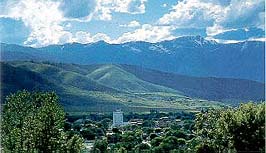

Community History
Baker City in the late 19th and early 20th
centuries.
Although it was located on the main route of the Oregon Trail,
Baker City only grew up and flourished as a regional center when serious
mining operations began in the nearby Blue and Wallowa Mountains in the
1860s.
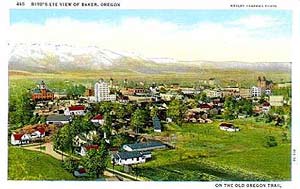 |
Founded in 1866 and incorporated in 1874, the town is also the county seat of Baker County, which was formed by Legislative Assembly in 1862. Because Baker City is on a railroad route—and located about halfway between Portland and Salt Lake City—it served as a popular overnight stopping point for early rail travelers. With such towns as Auburn, Sumpter, and Sparta close by, Baker City soon became the focal point of activity.
Unlike many other mining towns which boomed only briefly, Baker City enjoyed a sustained period of prosperity. Dubbed “Queen City of the Mines,” it was once considered to be the premier social center along the Oregon Trail (see color post card, 1920). The city’s prosperity was based not only on the steady influx of mine-related wealth, but also on ranching and timber interests. Toward the end of the Great Depression, however, the local economy flagged and Baker City went into a decline which only “bottomed out” in the mid-1980s.
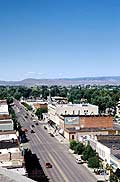 |
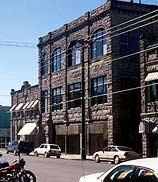 |
|
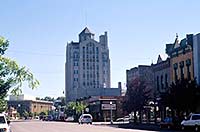 |
||
Baker Historic District now.
Today, Baker City is reviving and enjoying a new prosperity based largely
on its historic character and picturesque natural setting. A special element
providing strong continuity within the district was the historical use
of a locally quarried stone known as "volcanic tuff." (see
photo: LEFT) It was saw-quarried in a soft state and hardened upon
exposure to the air. The stone was first used in foundations and ornament,
but later, in the 1900s, many public and commercial buildings were constructed
substantially of volcanic tuff. It was generally used as rusticated rock-faced
ashlar in regular courses.
The historic district, which encompasses the commercial and civic centers of the town, was nominated to the National Register in 1978, and contains one of the best collections of stone buildings in Oregon. Styles of buildings range from Commercial Italianate to Moderne.
---------------------------------